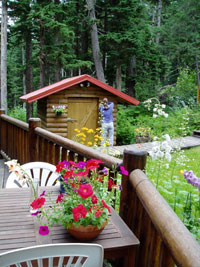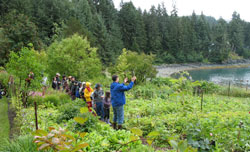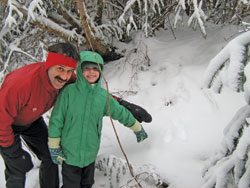Landscaping for Wildlife
Getting Started
 Any outdoor area can be modified to create a better home for wildlife. Landscaping for Wildlife will also make the
area more attractive to people, and may enhance the value of your property as well. You can even have your property
certified as an official Backyard Wildlife Habitat Site!
Any outdoor area can be modified to create a better home for wildlife. Landscaping for Wildlife will also make the
area more attractive to people, and may enhance the value of your property as well. You can even have your property
certified as an official Backyard Wildlife Habitat Site!
All animals require three basic elements to thrive: food, water, and cover for protection and a place to reproduce. You should consider all of these elements and how they relate to one another in space in order to develop a successful plan for enhancing the wildlife value of your landscape.
These web pages will help guide you through this process. Here are six basic steps to consider in Landscaping for Wildlife:
- Select your area
- Identify the resources already available to wildlife
- Develop your plan to enhance the wildlife values of your landscape
- Obtain your trees, shrubs, plants
- Get your hands dirty and plant!
- Observe your handiwork over the years and make changes as necessary
Select Your Area
 A large area (like your backyard) allows for more variety in planting and other wildlife enhancements, however
small areas (large enough for only a birdbath or some hanging plants) can make a difference to wildlife as well.
Landscaping a local space, such as a park, playground, or nursing home garden can make a terrific community project.
After selecting your space, make an informal sketch of the area as you begin thinking about places for plants and
flowers. Also note locations of hazards such as power lines, exhaust systems, wire fences, roads, large windows, and
other structures.
A large area (like your backyard) allows for more variety in planting and other wildlife enhancements, however
small areas (large enough for only a birdbath or some hanging plants) can make a difference to wildlife as well.
Landscaping a local space, such as a park, playground, or nursing home garden can make a terrific community project.
After selecting your space, make an informal sketch of the area as you begin thinking about places for plants and
flowers. Also note locations of hazards such as power lines, exhaust systems, wire fences, roads, large windows, and
other structures.
Identify the Resources Already Available to Wildlife
Start making a list of the food, water, and cover already found nearby. What an animal considers "food" will vary by species. Food resources can include berry producing shrubs, seed producing plants and trees, nectar producing flowers, pollen producing flowers that attract pollinating insects, standing dead wood or downed logs that harbor tasty insects, and even your plants themselves. "Cover" is also species dependant. Some birds nest on the ground in tall grass, some only in shrubs, while others require tall conifers, cavities, or steep embankments. Note what water sources are in your area or nearby. Is there a creek, ditch, or lake close by? Does your property have a pond or birdbath?
 List the types of trees and plants that are already found in your landscape. This will help you identify which
animals may already use your area, and which you are likely to attract. Which animals do you see here now? What
birds are nearby? Have you seen or heard wood frogs on your property in the spring? Learn as much as you can about
the mammals, birds, and amphibians that occur in your local area, so that you can plant appropriate food and cover.
The Alaska Department of Fish & Game and organizations like the National Wildlife Federation have great resources to
help find out about wildlife.
A great place to start is iNaturalist where you can find lists of the birds, mammals, amphibians, trees, wildflowers, garden plants, and noxious weeds for your specific zip-code!
List the types of trees and plants that are already found in your landscape. This will help you identify which
animals may already use your area, and which you are likely to attract. Which animals do you see here now? What
birds are nearby? Have you seen or heard wood frogs on your property in the spring? Learn as much as you can about
the mammals, birds, and amphibians that occur in your local area, so that you can plant appropriate food and cover.
The Alaska Department of Fish & Game and organizations like the National Wildlife Federation have great resources to
help find out about wildlife.
A great place to start is iNaturalist where you can find lists of the birds, mammals, amphibians, trees, wildflowers, garden plants, and noxious weeds for your specific zip-code!
